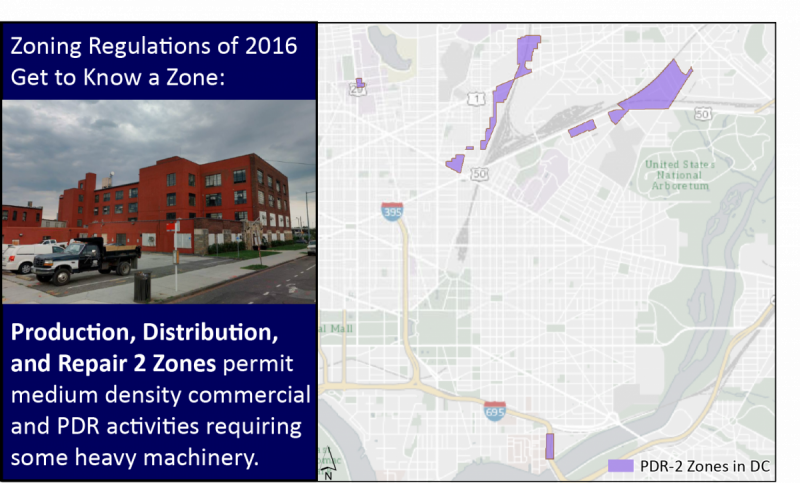Game of Zones: The other side of the bracket

Image by Peter Dovak used with permission.
Zoning laws shape the buildings that surround us, allowing tall office buildings here and single-family houses over there. The size and height of a building, where exactly it can go, and what activities can go on within it all fall under zoning laws. Since few people know much about the details of zoning, we've created Game of Zones as a fun way to learn about some of the rules that distinguish places in DC from one another.
Since it's March, we've used the DC's Office of Zoning's “Get to Know a Zone” feature from its fascinating Twitter feed to devise a bracket of 16 zoning districts from across the city (DC has a total of 101 zoning districts). Find out what makes each zone special, vote for your favorites, and root for your team in the comments!
Part two of our series has four matches, pitting eight zones found (at least in part) in the Northeast and Southeast quadrants of DC.
Northeast Quadrant
PDR-2 vs. MU-4
Image by District of Columbia Office of Zoning used with permission.
PDR-2 zoning is one of seven “industrial” zones in DC. It allows multi-story industrial and commercial buildings, but not residential uses (except for artist lofts). Examples include the warehouses along the Metropolitan Branch Trail in Eckington and Edgewood, and areas along New York Avenue NE.
Image by District of Columbia Office of Zoning used with permission.
MU-4 zoning allows the low-rise (2-4 stories) mixed-use development common along many of DC’s main streets: Wisconsin Avenue through Georgetown and Friendship Heights, Takoma, Mount Pleasant, Kennedy Street, Rhode Island Avenue, Good Hope Road, and even Eastern Market.
Vote for one!
RF-1 vs. NC-9 to NC-17
Image by District of Columbia Office of Zoning used with permission.
RF-1 zoning allows rowhouses with up to 3 stories and 2 units on small lots. Many of DC’s quintessential rowhouse streets in Capitol Hill, Shaw, Bloomingdale, Eckington, Park View, Columbia Heights, and Mount Pleasant are zoned RF-1. This zoning district used to be called R-4, and its rules were recently revised to limit “pop-ups.”
Image by District of Columbia Office of Zoning used with permission.
NC-9 to NC-17 zones might sound a bit risqué, but these are pretty similar to the MU-4, MU-5, and MU-7 zones elsewhere. They’re only found along H Street NE and their rules realize elements of its Strategic Development Plan, like the focus on entertainment near the Starburst and residential closer to Union Station.
Vote for one!
Southeast Quadrant
MU-7 vs. RA-1
Image by District of Columbia Office of Zoning used with permission.
MU-7 zoning allows the kind of busy mixed-use development found around several busy Metro station entrances, like Columbia Heights, Tenleytown, and Van Ness. It’s also the zoning for Skyland, Hechinger Mall, Minnesota-Benning, and between the Anacostia Arts Center and the “Big K” building.
Image by District of Columbia Office of Zoning used with permission.
RA-1 zoning allows a mix of low-rise apartments (often with large yards), rowhouses, and other residences, as well as institutional uses like universities. Examples include Fort Dupont, western Glover Park, Mayfair, Parkside, and many apartment complexes along Mississippi and Alabama avenues near Congress Heights. The American and Catholic campuses are also zoned RA-1.
Vote for one!
HE vs. R-1-B
Image by District of Columbia Office of Zoning used with permission.
The four HE zones are an example of a Special Purpose Zone. The Hill East redevelopment plan, for the old hospital site south of RFK stadium, includes specifics about the size and use of new buildings. The HE-1 to HE-4 zones use a “form-based” approach, focusing more on buildings’ shapes and less on land use than conventional zoning, to implement the Hill East plan.
Image by District of Columbia Office of Zoning used with permission.
R-1-B zoning is one of two R-1 districts reserved exclusively for detached single-family houses, with R-1-A requiring larger lots. Large areas of the city (about one-third of all residential land), including much of the northwestern third of DC but also Hillcrest, are zoned R-1.
Vote for one!
Come back next week to vote on the Quadrant Finalists in GGWash's Game of Zones!
